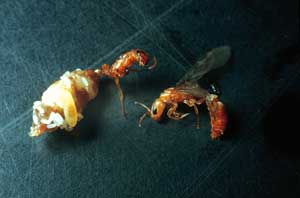|
|
 29 colony queen DHJanzen100111.jpg high resolution
|
|
| The colony queen from the tree in DHJanzen100103.jpg is on the left, and one of her virgin daughters (before a mating flight) is on the right. The colony queen has a fully distended abdomen because of her enormous functional ovaries that are producing a new egg every few minutes. If fertilized, the egg becomes a worker (usually) or a virgin queen (occasionally). If unfertilized, the egg becomes a male. The colony regulates the ratios of workers to queens to males, and produces males and females throughout the year. Note that all but two of her six legs have been amputated. This damage occurs when she is changing thorns. When she is to move to a new thorn, she stops reproducing and her abdomen slims somewhat. She then attempts to go out the exit hole in the thorn (which the workers also attempt to enlarge) but often gets stuck. The worker ants pull very hard on her legs to help her through the hole, and in the process sometimes cut or rip off pieces of legs. The fewer legs, the more likely she is to fall once out of the thorn and moving to the next. If she falls, the chance of loss of the queen by the colony is very high (the ants can pick her up from the ground and take her back up, but she has a good chance of being taken by a predator when on the ground). She has the physiology to survive 20 years of this treatment, but I suspect often does not. | ||
back to lecture slides
or skip to: